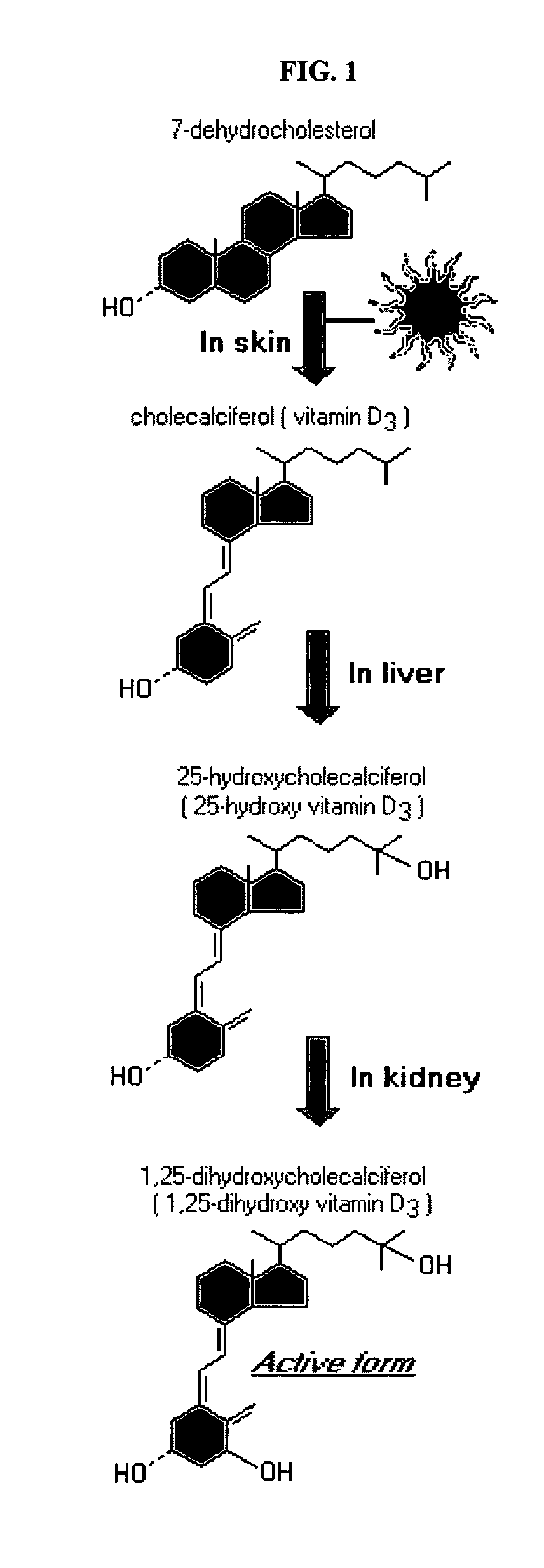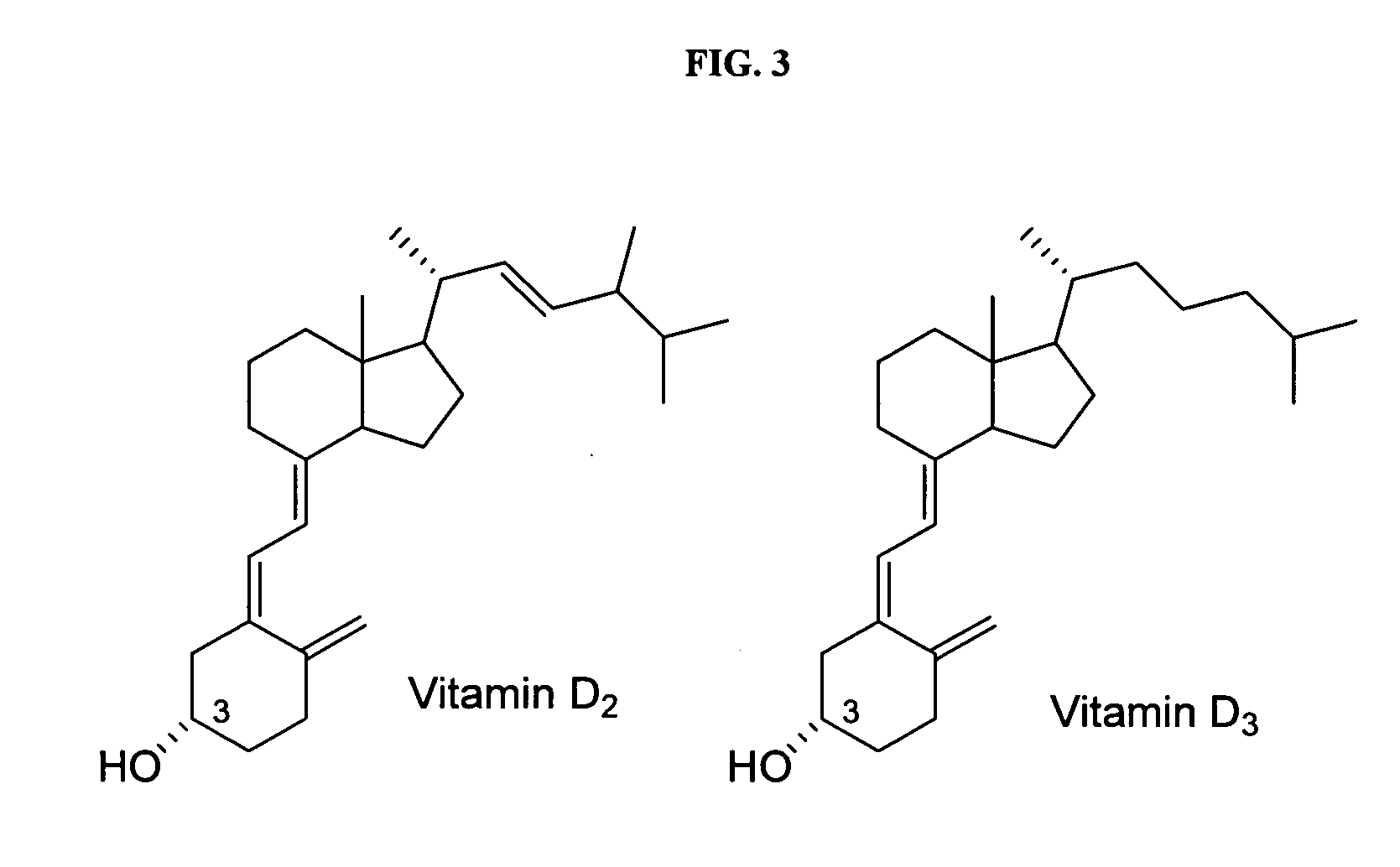Compositions and methods for inhibiting bone resorption
a technology of bisphosphonate and composition, applied in the direction of phosphorous compound active ingredients, biocide, animal husbandry, etc., can solve the problems of adversely affecting bisphosphonate absorption, bone formation, and bone resorption, so as to prevent, inhibit, inhibit or treat metabolic bone diseases, the effect of reducing the moisture level
- Summary
- Abstract
- Description
- Claims
- Application Information
AI Technical Summary
Benefits of technology
Problems solved by technology
Method used
Image
Examples
example 1
Bisphosphonate and Vitamin D Tablets
[0139] A finished drug product is a combination tablet containing alendronate sodium (about 70 mg anhydrous free acid equivalent) and vitamin D3 (about 2800 I.U. (about 70 μg)), with ingredients identified in Table 1-1. All of the excipients are compendial and were selected to achieve maximum physical and chemical stability.
TABLE 1-1Tablet CompositionAlendronate Sodium 70 mg / Vitamin D3 2800 I.U.TabletsIngredientmg / TabWeight %Alendronate Sodium91.3728.1%Dry Vitamin D3 10026.67 8.2%granulesMicrocrystalline131.040.3%Cellulose NFLactose Anhydrous62.3519.2%NFCroscarmellose9.740 3.0%Sodium NFColloidal Silicon0.81200.25%Dioxide NFMagnesium Stearate3.08700.95%NFTotal325 100%
The resulting tablets are used in accordance with the methods of the present invention for preventing, inhibiting, reducing or treating osteoporosis, for example. Similarly, tablets comprising other relative weights of alendronate, on an alendronic acid active basis are prepared i...
example 2
Bisphosphonate and Vitamin D Composition
[0140] A composition comprising a bisphosphonate and vitamin D may be prepared using mixing and formulation techniques as described in this specification. A composition containing about 35 mg of alendronate, on an alendronic acid active basis, and about 5,600 IU of vitamin D3 may be prepared using the following relative weights of ingredients.
IngredientPer TabletAlendronate Monosodium Trihydrate45.68mgDry Vitamin D3 100 granules56mg*Anhydrous Lactose, NF71.32mgMicrocrystalline Cellulose, NF80.0mgMagnesium Stearate, NF1.0mgCroscarmellose Sodium, NF2.0mg
*Granule contains approximately 100,000 IU per one gram; therefore 56 mg of the granule is equivalent to about 5600 IU.
The resulting dosage forms are used in accordance with the methods of the present invention for preventing, inhibiting, reducing or treating osteoporosis, for example. Similarly, dosage forms comprising other relative weights of alendronate, on an alendronic acid active bas...
example 3
Alendronate and Vitamin D Tablets
[0141] Tablets containing about 70 mg of alendronate, on an alendronic acid active basis, and 2800 IU of vitamin D3, are prepared using methods disclosed herein, using the following relative weights of ingredients:
TABLE 3-1Composition (per tablet):Alendronate sodium91.37mg†Silicon Dioxide, Colloidal, CAB-O-SIL P0.81mgDry Vitamin D3 100 granules‡26.67mg*Cellulose Microcrystalline NF Avicel PH-102131mgLactose NF Anhydrous63.35mgCroscarmellose Sodium Compendial9.74mgMagnesium Stearate NF (Non-Bovine)3.09mg
†Equivalent to 70.0 mg free acid
‡Dry Vitamin D3 100 granules also contained medium chain triglycerides, gelatin, sucrose, butylated hydroxytoluene, starch and sodium aluminum silicate.
*26.67 grams of the Dry Vitamin D3 100 granules contains 105,000 IU / g of vitamin D3.
The resulting tablets are used in accordance with the methods of the present invention for preventing, inhibiting, reducing or treating osteoporosis, for example. Similarly, tablet...
PUM
| Property | Measurement | Unit |
|---|---|---|
| concentrations | aaaaa | aaaaa |
| concentration | aaaaa | aaaaa |
| concentrations | aaaaa | aaaaa |
Abstract
Description
Claims
Application Information
 Login to View More
Login to View More - R&D
- Intellectual Property
- Life Sciences
- Materials
- Tech Scout
- Unparalleled Data Quality
- Higher Quality Content
- 60% Fewer Hallucinations
Browse by: Latest US Patents, China's latest patents, Technical Efficacy Thesaurus, Application Domain, Technology Topic, Popular Technical Reports.
© 2025 PatSnap. All rights reserved.Legal|Privacy policy|Modern Slavery Act Transparency Statement|Sitemap|About US| Contact US: help@patsnap.com



